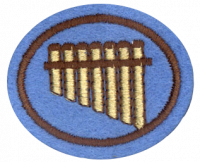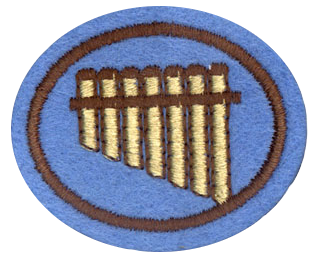Difference between revisions of "AY Honors/Whistles/Answer Key/es"
From Pathfinder Wiki
(Created page with "</noinclude> <!-- 18. Aprender a tocar una canción sencilla con cada silbato que ha hecho. -->") |
(Updating to match new version of source page) |
||
| (7 intermediate revisions by 2 users not shown) | |||
| Line 13: | Line 13: | ||
{{clear}} | {{clear}} | ||
| − | |||
{{clear}} | {{clear}} | ||
| − | |||
{{clear}} | {{clear}} | ||
| Line 31: | Line 29: | ||
{{clear}} | {{clear}} | ||
| − | |||
{{clear}} | {{clear}} | ||
| − | |||
{{clear}} | {{clear}} | ||
| Line 80: | Line 76: | ||
{{CloseReq}} <!-- 2 --> | {{CloseReq}} <!-- 2 --> | ||
{{ansreq|page={{#titleparts:{{PAGENAME}}|2|1}}|num=3}} | {{ansreq|page={{#titleparts:{{PAGENAME}}|2|1}}|num=3}} | ||
| − | <noinclude> | + | <noinclude></noinclude> |
| − | </noinclude> | + | <!-- 3. ¿Qué es lo que las estaciones del año tienen que ver con hacer un silbato de sauce? --> |
| − | <!-- 3. | ||
| − | |||
| − | |||
| − | |||
{{clear}} | {{clear}} | ||
| Line 96: | Line 88: | ||
{{CloseReq}} <!-- 3 --> | {{CloseReq}} <!-- 3 --> | ||
{{ansreq|page={{#titleparts:{{PAGENAME}}|2|1}}|num=4}} | {{ansreq|page={{#titleparts:{{PAGENAME}}|2|1}}|num=4}} | ||
| − | <noinclude> | + | <noinclude></noinclude> |
| − | </noinclude> | + | <!-- 4. Nombrar dos árboles que hacen los mejores silbatos y por qué. Hacer una lista de otros tres árboles que se pueden utilizar para hacer silbatos. --> |
| − | <!-- 4. | ||
| − | |||
| − | + | {{clear}} | |
| − | |||
| − | |||
| − | + | {{clear}} | |
| − | |||
| − | |||
| − | |||
| − | |||
| − | |||
<noinclude></noinclude> | <noinclude></noinclude> | ||
{{CloseReq}} <!-- 4 --> | {{CloseReq}} <!-- 4 --> | ||
{{ansreq|page={{#titleparts:{{PAGENAME}}|2|1}}|num=5}} | {{ansreq|page={{#titleparts:{{PAGENAME}}|2|1}}|num=5}} | ||
| − | <noinclude> | + | <noinclude></noinclude> |
| − | </noinclude> | + | <!-- 5. Dar una breve descripción de los siguientes estilos de silbatos: --> |
| − | <!-- 5. | + | <noinclude></noinclude> |
| − | <noinclude | ||
| − | |||
{{ansreq|page={{#titleparts:{{PAGENAME}}|2|1}}|num=5a}} | {{ansreq|page={{#titleparts:{{PAGENAME}}|2|1}}|num=5a}} | ||
<noinclude></noinclude> | <noinclude></noinclude> | ||
| Line 137: | Line 118: | ||
{{CloseReq}} <!-- 5 --> | {{CloseReq}} <!-- 5 --> | ||
{{ansreq|page={{#titleparts:{{PAGENAME}}|2|1}}|num=6}} | {{ansreq|page={{#titleparts:{{PAGENAME}}|2|1}}|num=6}} | ||
| − | <noinclude> | + | <noinclude></noinclude> |
| − | </noinclude> | + | <!-- 6. Nombrar cinco clases de silbatos y sus usos. --> |
| − | <!-- 6. | ||
| − | |||
| − | |||
| − | |||
| − | |||
| − | |||
| − | |||
<noinclude></noinclude> | <noinclude></noinclude> | ||
{{CloseReq}} <!-- 6 --> | {{CloseReq}} <!-- 6 --> | ||
{{ansreq|page={{#titleparts:{{PAGENAME}}|2|1}}|num=7}} | {{ansreq|page={{#titleparts:{{PAGENAME}}|2|1}}|num=7}} | ||
| − | <noinclude> | + | <noinclude></noinclude> |
| − | </noinclude> | + | <!-- 7. ¿Qué instrumento musical moderno es un sofisticado silbato? --> |
| − | <!-- 7. | ||
| − | |||
| − | |||
{{clear}} | {{clear}} | ||
| Line 166: | Line 137: | ||
{{CloseReq}} <!-- 7 --> | {{CloseReq}} <!-- 7 --> | ||
{{ansreq|page={{#titleparts:{{PAGENAME}}|2|1}}|num=8}} | {{ansreq|page={{#titleparts:{{PAGENAME}}|2|1}}|num=8}} | ||
| − | <noinclude> | + | <noinclude></noinclude> |
| − | </noinclude> | + | <!-- 8. ¿Cómo funciona un silbato? --> |
| − | <!-- 8. | ||
| − | |||
| − | |||
<noinclude></noinclude> | <noinclude></noinclude> | ||
{{CloseReq}} <!-- 8 --> | {{CloseReq}} <!-- 8 --> | ||
{{ansreq|page={{#titleparts:{{PAGENAME}}|2|1}}|num=9}} | {{ansreq|page={{#titleparts:{{PAGENAME}}|2|1}}|num=9}} | ||
| − | <noinclude> | + | <noinclude></noinclude> |
| − | </noinclude> | + | <!-- 9. ¿Cuál es el equipo más común utilizado en hacer silbatos? --> |
| − | <!-- 9. | ||
| − | |||
| − | |||
{{clear}} | {{clear}} | ||
| Line 186: | Line 151: | ||
{{CloseReq}} <!-- 9 --> | {{CloseReq}} <!-- 9 --> | ||
{{ansreq|page={{#titleparts:{{PAGENAME}}|2|1}}|num=10}} | {{ansreq|page={{#titleparts:{{PAGENAME}}|2|1}}|num=10}} | ||
| − | <noinclude> | + | <noinclude></noinclude> |
| − | </noinclude> | + | <!-- 10. Explicar la importancia de la veta de la madera en el tallado de un silbato. --> |
| − | <!-- 10. | ||
| − | |||
| − | |||
<noinclude></noinclude> | <noinclude></noinclude> | ||
{{CloseReq}} <!-- 10 --> | {{CloseReq}} <!-- 10 --> | ||
{{ansreq|page={{#titleparts:{{PAGENAME}}|2|1}}|num=11}} | {{ansreq|page={{#titleparts:{{PAGENAME}}|2|1}}|num=11}} | ||
| − | <noinclude> | + | <noinclude></noinclude> |
| − | </noinclude> | + | <!-- 11. ¿Por qué el tamaño de lo agujeros y la cámara debe ser proporcional a la cantidad de fluje de aire? --> |
| − | <!-- 11. | ||
| − | |||
| − | |||
<noinclude></noinclude> | <noinclude></noinclude> | ||
{{CloseReq}} <!-- 11 --> | {{CloseReq}} <!-- 11 --> | ||
{{ansreq|page={{#titleparts:{{PAGENAME}}|2|1}}|num=12}} | {{ansreq|page={{#titleparts:{{PAGENAME}}|2|1}}|num=12}} | ||
| − | <noinclude> | + | <noinclude></noinclude> |
| − | </noinclude> | + | <!-- 12. ¿Cómo ajustar/entonar un silbato? --> |
| − | <!-- 12. | ||
| − | |||
| − | |||
<noinclude></noinclude> | <noinclude></noinclude> | ||
{{CloseReq}} <!-- 12 --> | {{CloseReq}} <!-- 12 --> | ||
{{ansreq|page={{#titleparts:{{PAGENAME}}|2|1}}|num=13}} | {{ansreq|page={{#titleparts:{{PAGENAME}}|2|1}}|num=13}} | ||
| − | <noinclude> | + | <noinclude></noinclude> |
| − | </noinclude> | + | <!-- 13. Demostrar que se puede hacer un silbato de dos manos usando sus manos y un trozo de césped. --> |
| − | <!-- 13. | ||
| − | |||
| − | |||
| − | |||
| − | |||
| − | |||
| − | |||
{{clear}} | {{clear}} | ||
| Line 228: | Line 177: | ||
{{CloseReq}} <!-- 13 --> | {{CloseReq}} <!-- 13 --> | ||
{{ansreq|page={{#titleparts:{{PAGENAME}}|2|1}}|num=14}} | {{ansreq|page={{#titleparts:{{PAGENAME}}|2|1}}|num=14}} | ||
| − | <noinclude> | + | <noinclude></noinclude> |
| − | </noinclude> | + | <!-- 14. Demostrar la técnica y tratar de lograr un silbido utilizando las manos o los dedos. --> |
| − | <!-- 14. | ||
| − | |||
| − | |||
| − | |||
| − | |||
| − | |||
| − | |||
| − | |||
<noinclude></noinclude> | <noinclude></noinclude> | ||
| Line 244: | Line 185: | ||
<noinclude></noinclude> | <noinclude></noinclude> | ||
<!-- 15. Revisar y demostrar primeros auxilios adecuados y normas de seguridad para el uso de una navaja de bolsillo. --> | <!-- 15. Revisar y demostrar primeros auxilios adecuados y normas de seguridad para el uso de una navaja de bolsillo. --> | ||
| − | {{: | + | {{:AY Honors/First aid/Bleeding/es}}<br /> |
| − | Para más información, véase la especialidad de [[AY Honors/First Aid, Basic/es|Primeros | + | Para más información, véase la especialidad de [[AY Honors/First Aid, Basic/es|Primeros auxilios]]. |
===Seguridad con la navaja=== | ===Seguridad con la navaja=== | ||
| − | {{: | + | {{:AY Honors/Camping/Knife safety/es}} |
<noinclude></noinclude> | <noinclude></noinclude> | ||
| Line 263: | Line 204: | ||
{{CloseReq}} <!-- 16 --> | {{CloseReq}} <!-- 16 --> | ||
{{ansreq|page={{#titleparts:{{PAGENAME}}|2|1}}|num=17}} | {{ansreq|page={{#titleparts:{{PAGENAME}}|2|1}}|num=17}} | ||
| − | <noinclude> | + | <noinclude></noinclude> |
| − | </noinclude> | + | <!-- 17. Realizar los siguientes silbatos: --> |
| − | <!-- 17. | + | <noinclude></noinclude> |
| − | <noinclude | ||
| − | |||
{{ansreq|page={{#titleparts:{{PAGENAME}}|2|1}}|num=17a}} | {{ansreq|page={{#titleparts:{{PAGENAME}}|2|1}}|num=17a}} | ||
<noinclude></noinclude> | <noinclude></noinclude> | ||
| Line 307: | Line 246: | ||
<noinclude></noinclude> | <noinclude></noinclude> | ||
==Referencias== | ==Referencias== | ||
| − | |||
<noinclude></noinclude> | <noinclude></noinclude> | ||
{{CloseHonorPage}} | {{CloseHonorPage}} | ||
Latest revision as of 21:21, 14 July 2022
1
Relatar brevemente la historia de cómo se fabricaron los silbatos y decir por qué se inventaron.
2
Explicar la importancia de la conservación en lo que respecta a hacer silbatos.
3
¿Qué es lo que las estaciones del año tienen que ver con hacer un silbato de sauce?
4
Nombrar dos árboles que hacen los mejores silbatos y por qué. Hacer una lista de otros tres árboles que se pueden utilizar para hacer silbatos.
5
Dar una breve descripción de los siguientes estilos de silbatos:
5a
Silbatos tipo tubo
5b
Silbatos tipo pan (flauta de pan)
5c
Silbatos tipo flauta
6
Nombrar cinco clases de silbatos y sus usos.
7
¿Qué instrumento musical moderno es un sofisticado silbato?
8
¿Cómo funciona un silbato?
9
¿Cuál es el equipo más común utilizado en hacer silbatos?
10
Explicar la importancia de la veta de la madera en el tallado de un silbato.
11
¿Por qué el tamaño de lo agujeros y la cámara debe ser proporcional a la cantidad de fluje de aire?
12
¿Cómo ajustar/entonar un silbato?
13
Demostrar que se puede hacer un silbato de dos manos usando sus manos y un trozo de césped.
14
Demostrar la técnica y tratar de lograr un silbido utilizando las manos o los dedos.
15
Revisar y demostrar primeros auxilios adecuados y normas de seguridad para el uso de una navaja de bolsillo.
Si ve a una persona que está sangrando mucho, puede hacer lo siguiente:
- Presione duro sobre la herida para detener el sangrado.
- Si se corta un brazo o una pierna, eleve el miembro.
- Cubra con una almohadilla limpia y ponga un vendaje.
- Verifique que el sangrado se ha detenido. Si no es así, puede añadir otra almohadilla y otro vendaje; no quite el vendaje anterior.
- Si ha vendado una extremidad, verifique frecuentemente que los dedos de la mano y dedos de los pies se mantienen cálidos. Si los dedos se están enfriando, afloje el vendaje para que la sangre circule.
- Para un sangrado severo (5 tazas de sangre o más), lleve a la persona a un hospital para recibir puntos de sutura (y posiblemente una inmunización contra el tétano) y mantenga la extremidad elevada.
Para más información, véase la especialidad de Primeros auxilios.
- Mantenga las cuchillas afiladas. Un cuchillo sin filo es difícil de empujar a través de la madera, lo que requiere una fuerza adicional. Cuando la madera finalmente se corta, la cuchilla sigue adelante.
- Empuje siempre la hoja lejos de usted y considere constantemente la dirección de la hoja.
- Mantenga sus dedos alejados de la hoja en todo momento.
- Cuando parte la madera con un cuchillo, no clave en la parte posterior de la hoja. Esto debilita el apego a la empuñadura y la hoja se deforma.
- Cierre una navaja de bolsillo cuando no está en uso o cuando la lleva.
- Mantenga todo cuchillo lejos del calor. El calor suavizará la navaja. Una navaja suave no dará una ventaja, por lo que es casi imposible mantenerla aguda.
16
Saber cómo afilar una navaja utilizando una piedra húmeda para afilar o una piedra de aceite para afilar.
17
Realizar los siguientes silbatos:
17a
Flauta de pan (tubos)
17b
Flauta
18
Aprender a tocar una canción sencilla con cada silbato que ha hecho.


